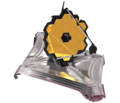File:Atmospheric methane of brown dwarfs W1935 and W2220 (NIRSpec) (browndwarfs-aurora).jpg
页面内容不支持其他语言。
外观

本预览的尺寸:800 × 511像素。 其他分辨率:320 × 205像素 | 640 × 409像素 | 1,024 × 654像素 | 1,280 × 818像素 | 2,560 × 1,636像素 | 15,998 × 10,225像素。
原始文件 (15,998 × 10,225像素,文件大小:10.23 MB,MIME类型:image/jpeg)
摘要
| 警告 | 部分浏览器在浏览此图片的完整大小时可能会遇到困难:该图片中有数量巨大的像素点,可能无法完全载入或者导致您的浏览器停止响应。 | 交互式大图查看器 |
|---|
| 描述Atmospheric methane of brown dwarfs W1935 and W2220 (NIRSpec) (browndwarfs-aurora).jpg |
English: Astronomers used the NASA/ESA/CSA James Webb Space Telescope to study 12 cold brown dwarfs. Two of them – W1935 and W2220 – appeared to be near twins of each other in composition, brightness, and temperature. However, W1935 showed emission from methane, as opposed to the anticipated absorption feature that was observed toward W2220. The team speculates that the methane emission may be due to processes generating aurorae.W1935 is the first auroral candidate outside the Solar System with the signature of methane emission. It’s also the coldest auroral candidate outside our solar system, with an effective temperature of about 200 degrees Celsius, over 300 degrees Celsius warmer than Jupiter.In our Solar System the solar wind is a primary contributor to auroral processes, with active moons like Io and Enceladus playing a role for planets like Jupiter and Saturn, respectively. W1935 lacks a companion star entirely, so a stellar wind cannot contribute to the phenomenon. It is yet to be seen whether an active moon might play a role in the methane emission on W1935. These findings were presented at the 243rd meeting of the American Astronomical Society. |
| 日期 | 2024年1月9日, 17:15:00 (上传日期) |
| 来源 | Atmospheric methane of brown dwarfs W1935 and W2220 (NIRSpec) |
| 作者 | NASA, ESA, CSA, L. Hustak (STScI) |
| 其他版本 |
|
许可协议
| ESA/Webb images, videos and web texts are released by the ESA under the Creative Commons Attribution 4.0 International license and may on a non-exclusive basis be reproduced without fee provided they are clearly and visibly credited. Detailed conditions are below; see the ESA copyright statement for full information. For images created by NASA or on the webbtelescope.org website, use the {{PD-Webb}} tag.
Conditions:
Notes:
|
 |
说明
添加一行文字以描述该文件所表现的内容
Astronomers used the NASA/ESA/CSA James Webb Space Telescope to study 12 cold brown dwarfs. Two of them – W1935 and W2220 – appeared to be near twins of each other in composition, brightness, and temperature.
此文件中描述的项目
描繪內容
image/jpeg
10,225 像素
15,998 像素
10,723,181 字节
9 1 2024
425n06msr0o4agqklvv2jrtov1cthfru237x6y20lqc6hsujvz
文件历史
点击某个日期/时间查看对应时刻的文件。
| 日期/时间 | 缩略图 | 大小 | 用户 | 备注 | |
|---|---|---|---|---|---|
| 当前 | 2024年1月10日 (三) 10:02 |  | 15,998 × 10,225(10.23 MB) | OptimusPrimeBot | #Spacemedia - Upload of https://cdn.esawebb.org/archives/images/large/browndwarfs-aurora.jpg via Commons:Spacemedia |
文件用途
以下页面使用本文件:
全域文件用途
以下其他wiki使用此文件:
- en.wikipedia.org上的用途
元数据
此文件中包含有扩展的信息。这些信息可能是由数码相机或扫描仪在创建或数字化过程中所添加。
如果此文件的源文件已经被修改,一些信息在修改后的文件中将不能完全反映出来。
| 来源 | ESA/Webb |
|---|---|
| 提供者 | NASA, ESA, CSA, L. Hustak (STScI) |
| 图像标题 |
|
| 简短标题 |
|
| 使用条款 |
|
| 数据生成日期时间 | 2024年1月9日 (二) 17:15 |
| JPEG文件备注 | Astronomers used the NASA/ESA/CSA James Webb Space Telescope to study 12 cold brown dwarfs. Two of them – W1935 and W2220 – appeared to be near twins of each other in composition, brightness, and temperature. However, W1935 showed emission from methane, as opposed to the anticipated absorption feature that was observed toward W2220. The team speculates that the methane emission may be due to processes generating aurorae. W1935 is the first auroral candidate outside the Solar System with the signature of methane emission. It’s also the coldest auroral candidate outside our solar system, with an effective temperature of about 200 degrees Celsius, over 300 degrees Celsius warmer than Jupiter. In our Solar System the solar wind is a primary contributor to auroral processes, with active moons like Io and Enceladus playing a role for planets like Jupiter and Saturn, respectively. W1935 lacks a companion star entirely, so a stellar wind cannot contribute to the phenomenon. It is yet to be seen whether an active moon might play a role in the methane emission on W1935. These findings were presented at the 243rd meeting of the American Astronomical Society. |
| 使用软件 | GIMP 2.10.34 |
| 原始文件唯一ID | uuid:65E6390686CF11DBA6E2D887CEACB407 |
| 数字化日期时间 | 2024年1月8日 (一) 05:07 |
| 联系信息 |
ESA Office, Space Telescope Science Institute, 3700 San Martin Dr Baltimore, MD, 21218 United States |
| IIM版本 | 4 |


